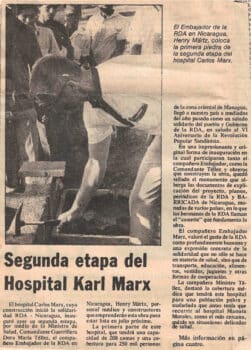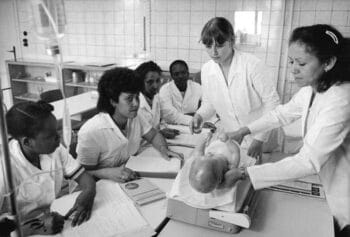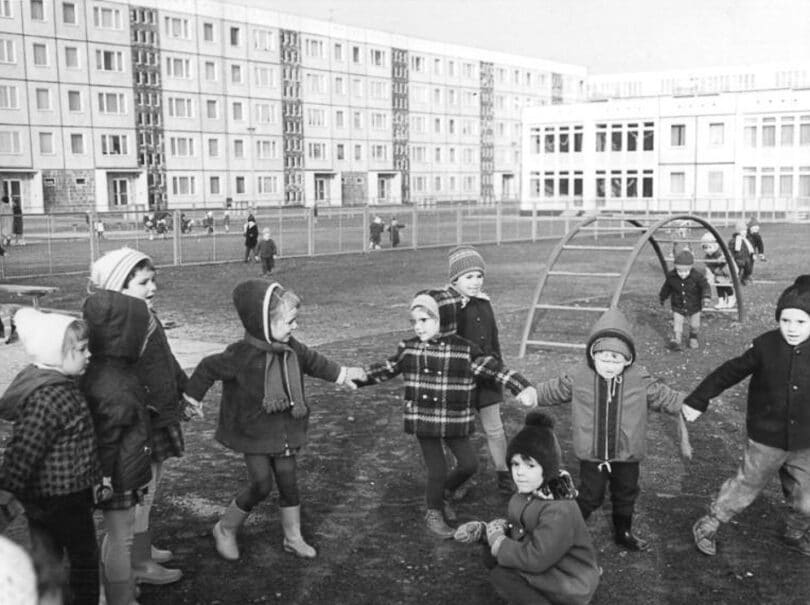Dear friends,
Greetings from the desk of Tricontinental: Institute for Social Research.

In this article, copied from an entry in Dr. Rüdiger Feltz’s Nicaragua diary on 15 March 1986, the Nicaraguan press reports on the construction of the Carlos Marx Hospital, which started as a triage tent and was soon expanded into a fully functioning hospital. The hospital’s construction as well as the training of its staff and provision of its equipment and medicines were organised by DDR officials and financed by donations from DDR citizens. It was one of East Germany’s largest solidarity projects.
A few years ago, a minor medical problem took me to the Hospital Alemán-Nicaragüense in Nicaragua’s capital, Managua. While I was being treated, I asked the doctor, a kindly older man, if the hospital had been built in association with a German missionary organisation, given its name (in Spanish, alemán means ‘German’). No, he said: this hospital used to be called the Carlos Marx Hospital, and it was built in collaboration with the German Democratic Republic (DDR), or East Germany, in the 1980s. The DDR worked with Nicaragua’s Sandinista government to build the hospital in the working-class area of Xolotlán, where three hundred thousand people lived without access to health care. A massive solidarity campaign in the DDR helped raise funds for the project, and East German medical professionals travelled to Xolotlán to set up a camp of provisional medical tents before beginning construction. The brick-and-mortar hospital opened on 23 July 1985.
When the Sandinista National Liberation Front (FSLN) took power in 1979, the revolutionaries inherited a country where infant mortality rates had skyrocketed to 82 per thousand live births (which would be the highest rate in the world today) and where health care was a privilege restricted to a small minority of the population. Besides, by the time the FSLN rode into Managua, whatever health care apparatus had been built by the regime of the Somoza family during their 43-year rule had been shattered: the 1972 earthquake destroyed 70% of the city’s buildings, including the military and Baptist hospitals and most of its health care facilities. The Carlos Marx Hospital was an act of immense solidarity by the socialists, built in Managua on the ruins of a society brutalised by the country’s oligarchy and by their enablers in Washington (as U.S. President Franklin D. Roosevelt said in 1939 of the dictator at the time, ‘Somoza may be a son of a bitch, but he’s our son of a bitch’). Socialist internationalism, from the DDR’s assistance to the efforts of Cuban medical personnel, along with the development of the Sandinista health campaigns, markedly improved the lives of Nicaraguans.
I was reminded of the Carlos Marx Hospital by the newest edition in our series Studies on the DDR, jointly produced by Tricontinental: Institute for Social Research and the Internationale Forschungsstelle DDR (IFDDR) and entitled ‘Socialism Is the Best Prophylaxis’: The German Democratic Republic’s Health Care System. The information about the Carlos Marx Hospital comes from a brief section in the study on the DDR’s international medical solidarity, which also included, among many other examples, building a hospital in Vietnam during the U.S. war on that country and training thousands of doctors from across the Third World in the DDR. But the study is not focused on medical solidarity, which was a part of the DDR’s wider socialist internationalism that will be taken up in a later edition in the series.
The study is about the DDR’s attempt to create a humane and just health care system in a country devastated by World War II, with few resources available (and a population one-third the size of West Germany’s). The title of the study, ‘Socialism Is the Best Prophylaxis’, comes from a statement made by Dr. Maxim Zetkin (1883—1965), the son of the communist and international women’s rights activist Clara Zetkin (1857—1933). Zetkin’s words became a widely propagated slogan in the DDR and the leitmotif for the public health care system that the DDR sought to build with and for its population, emphasising that health care must be preventative, or prophylactic, and not reactive, or merely concerned with treating illness and injury after they occur. Truly preventative care did not reduce health to medical treatment but focused on the general well-being of the population by continuously improving living and working conditions. The DDR recognised that health must be understood as a social responsibility and a priority in all policies, from workplace safety to women’s universal access to reproductive care, nutrition and check-ups in kindergarten and school, and the need to guarantee holidays for the working class. But Zetkin’s quote also highlights how preventive care can only be realised by a system that eliminates the profit motive, which inevitably results in the exploitation of care workers, inflated prices, patents on life-saving medication, and artificial scarcity.

The DDR’s Dorothea Christiane Erxleben Medical School, named after Germany’s first female medical doctor, emphasised medical pedagogy. The objective was to train students so that they could in turn teach trainees in their home countries, thereby promoting the development and autonomy of local health care systems.
The DDR created a network of medical institutions that worked to improve diet and lifestyle as well as to identify and treat ailments early on rather than wait for them to develop into more severe illnesses. All of this had to be built in a heavily sanctioned country where the physical infrastructure had been destroyed by the war and where many doctors fled to the West (largely because roughly 45 percent of German physicians had been Nazi Party members, and they knew that they would be treated leniently in the West while they would likely be prosecuted in the DDR and in the Soviet Union).
The DDR’s commitment to comprehensive health care was based on the idea of social medicine (Sozialhygiene), developed by the founder of modern pathology Rudolf Virchow (1821—1902) to examine the socio-political determinants of health, and on the Soviet Semashko ‘single payer’ health care system, developed by Nikolai Semashko, People’s Commissar for Health in the Soviet Union from 1918 to 1930.
Among the key aspects of the DDR’s health care system detailed in our study are polyclinics and the community nurse system. When a person in the DDR felt sick, that person would go to a polyclinic, which would be located within their neighbourhood or workplace. Any person could walk into the polyclinic, inform the staff of their ailment, and see a doctor, who would, in turn, direct them to one of the clinic’s many specialist departments (such as internal medicine, oral medicine, gynaecology, surgery, paediatrics, and general medicine). Medical professionals were publicly employed and remunerated and could thus focus on healing the patient rather than on prescribing unnecessary tests and medicines simply to overbill insurance companies or the patients. The different medical professionals and specialists who worked in a single polyclinic consulted each other to find the best course of treatment. Furthermore, on average, 18 to 19 doctors worked in each clinic, allowing for extended hours of operations.

Community nursing was a highly skilled and valued profession. The nurses were well acquainted with the residents in their region and performed important medical services during house visits such as carrying out examinations, dressing wounds, administering medicines and injections, and arranging for a doctor’s assistance when necessary.
The DDR was not the only place to build a health care system based on this kind of socialist polyclinic format: two years ago, Tricontinental: Institute for Social Research published dossier no. 25 on the polyclinics run by communists in the Telugu-speaking regions of India, entitled People’s Polyclinics: The Initiative of the Telugu Communist Movement. The most vital aspect of these polyclinics for our time is that no money was exchanged for care (which is particularly notable in India, where there are extraordinarily high out-of-pocket expenses for health care).
One paragraph in our study stopped me in my tracks:
In order to extend preventive care to rural areas and scattered villages, rural outpatient centres were built and staffed with up to three doctors, with the number of these facilities rising from 250 in 1953 to 433 by 1989. In many towns, physicians worked in public medical practices or temporarily staffed field offices to provide residents with consultation hours and home visits, while mobile dental clinics visited remote villages to provide all children with preventive care. In addition, the profession of the community nurse was developed in the early 1950s to alleviate the initial shortage of doctors in the countryside, with the number of community nurses expanding from 3,571 in 1953 to 5,585 by 1989. This extensive rural infrastructure helped to provide less densely populated regions with medical services comparable to what was available in urban areas.
In 2015, the International Labour Organisation published a report that found that 56 per cent of rural population worldwide lacks health coverage, with the highest deficit found in Africa, followed by Latin America and Asia. Meanwhile, in the DDR—which lasted a mere forty-one years, from 1949 to 1990—the socialist project built a rural health care system that linked every resident to the polyclinics in nearby towns through the Gemeindeschwester(community nurse) system. The nurse would get to know every one of the residents in the village, give preliminary diagnoses, and either offer treatments or await the weekly visit of a doctor to each village. When the DDR was dismantled and absorbed into unified Germany in 1990, the community nurse system was disbanded, all 5,585 community nurses were laid off, and rural health care in the country collapsed.

The Proletarian Health Service (PGD) was a self-organised health service that operated from 1921 to 1926. It was explicitly political and continued the tradition of public health by, for instance, supporting the nutrition of schoolchildren and the labour struggles to maintain the eight-hour day, especially in the mining industry and chemical factories. It further advocated for the socialisation of health care and organised concrete, practical assistance by providing health care training and education, accident prevention, and first aid. The PGD also worked closely with the workers’ sports movement to promote fitness.
We hope you will join us in an online panel discussion on February 28 to discuss how socialist systems of the past and present have transformed health care to serve the needs of the people rather than profit.
Northwest of Managua, in the city of León, lived the poet Alfonso Cortés (1893—1969), who had been declared ‘mad’ at the age of 34 and chained in his bedroom. Another of Nicaragua’s great poets, Ernesto Cardenal (1925—2020), grew up not far from the home of Cortés. As a child, Cardenal said he used to walk by the Cortés home from the Christian Brothers School and once he saw the ‘poeta loco’ in his chains. A lack of health care condemned Cortés to this humiliation. On one occasion, on his way to see a doctor in Managua, Cortés was driven past a thousand-year-old Genízaro tree in Nagarote, a tree to whom the ‘poeta loco’ wrote a beautiful poem of hope:
I love you, old tree, because at all hours,
you generate mysteries and destinies
in the voice of the afternoon winds
or the birds at dawn.
You who the public plaza decorate,
thinking thoughts more divine
than those of man, indicating the paths
with your proud and sonorous branches.
Genízaro, your old scars
where, like an in an old book, it is written
what time does in its constant falling;
But your leaves are fresh and happy
and you make your treetop tremble into infinity
while humankind goes forward.
Warmly,
Vijay

